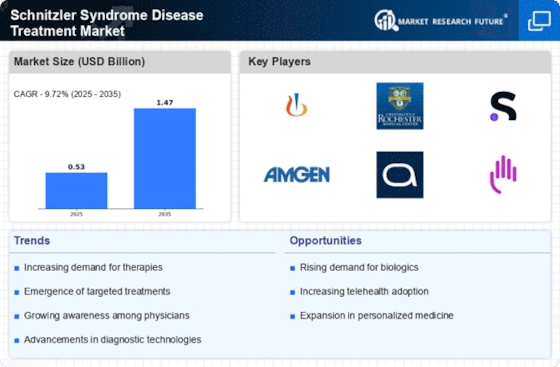Increased Awareness and Education
The growing awareness and education surrounding Schnitzler Syndrome are crucial drivers for the Schnitzler Syndrome Disease Treatment Market. As healthcare professionals and patients become more informed about the condition, there is a greater likelihood of timely diagnosis and treatment. Educational initiatives, including workshops and seminars, are being implemented to enhance understanding of Schnitzler Syndrome among medical practitioners. This increased awareness may lead to a rise in referrals to specialists and a subsequent uptick in treatment options being explored. Consequently, the market is poised for growth as more patients seek effective therapies to manage their symptoms and improve their quality of life.
Advancements in Diagnostic Techniques
Innovations in diagnostic methodologies are significantly influencing the Schnitzler Syndrome Disease Treatment Market. Enhanced imaging techniques and biomarker identification have improved the accuracy of Schnitzler Syndrome diagnoses, allowing for earlier intervention and better management of the disease. As diagnostic capabilities advance, healthcare professionals are more equipped to identify Schnitzler Syndrome, which may lead to an increase in treatment initiation rates. This trend is likely to drive market growth, as timely diagnosis is crucial for effective treatment outcomes. Furthermore, the integration of advanced diagnostics into clinical practice may encourage pharmaceutical companies to invest in the development of targeted therapies, thereby expanding the treatment landscape for Schnitzler Syndrome.
Emergence of Novel Therapeutic Agents
The introduction of novel therapeutic agents is a key driver for the Schnitzler Syndrome Disease Treatment Market. Recent advancements in drug development have led to the creation of targeted therapies that specifically address the underlying mechanisms of Schnitzler Syndrome. These innovative treatments are likely to offer improved efficacy and safety profiles compared to traditional therapies. As pharmaceutical companies continue to invest in research and development, the market may see a diversification of treatment options available to patients. This expansion of therapeutic agents is expected to enhance patient outcomes and satisfaction, thereby contributing to the overall growth of the Schnitzler Syndrome Disease Treatment Market.
Rising Prevalence of Schnitzler Syndrome
The increasing incidence of Schnitzler Syndrome is a pivotal driver for the Schnitzler Syndrome Disease Treatment Market. As awareness of this rare condition grows, more patients are being diagnosed, leading to a heightened demand for effective treatment options. Recent estimates suggest that the prevalence of Schnitzler Syndrome may be underreported, with actual cases potentially being higher than previously thought. This rise in diagnosed cases is likely to stimulate research and development efforts, as pharmaceutical companies seek to address the unmet medical needs of this patient population. Consequently, the market for Schnitzler Syndrome treatments is expected to expand, as healthcare providers and patients alike seek innovative therapies to manage symptoms and improve quality of life.
Growing Investment in Rare Disease Research
The surge in investment directed towards rare disease research is a significant catalyst for the Schnitzler Syndrome Disease Treatment Market. Governments and private organizations are increasingly recognizing the need to address the challenges posed by rare diseases, including Schnitzler Syndrome. Funding initiatives and grants aimed at fostering research in this area are likely to enhance the understanding of the disease and facilitate the development of novel therapeutic options. As a result, the market may witness an influx of innovative treatments, which could improve patient outcomes and drive market growth. This trend reflects a broader commitment to addressing the needs of patients with rare conditions, thereby potentially transforming the treatment landscape for Schnitzler Syndrome.


















Leave a Comment